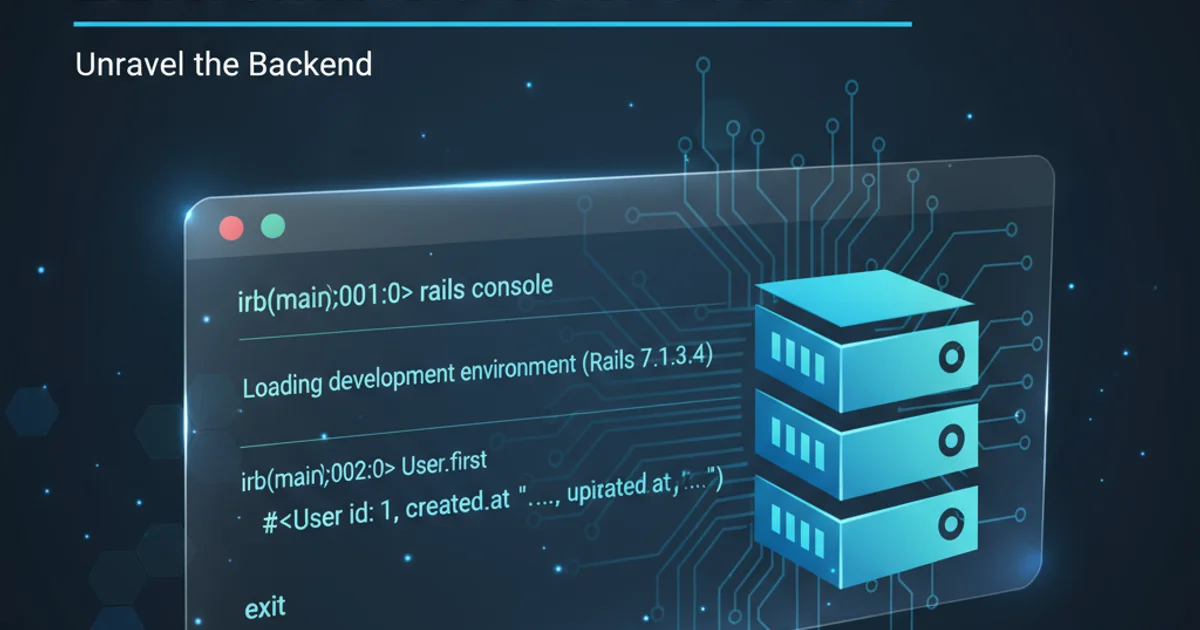Explore Running Rails Server Environment from Console
Categories:
Mastering Your Rails Server Environment from the Console

Unlock the power of the Rails console to inspect, debug, and interact with your running Rails application server environment. Learn how to access server-side variables, configurations, and more.
The Rails console (rails console or rails c) is an incredibly powerful tool for interacting with your Rails application. While commonly used for database operations and model testing, it also provides a unique window into your application's server environment. This article will guide you through exploring and manipulating aspects of your running Rails server directly from the console, enhancing your debugging and development workflow.
Understanding the Rails Console Context
When you launch the Rails console, you're essentially running an IRB (Interactive Ruby Shell) session within the context of your Rails application. This means all your application's classes, modules, and configurations are loaded and accessible. Crucially, the console also provides access to the app and helper objects, which simulate a request context, allowing you to interact with controllers, views, and routes as if a request were being processed.
# Start the Rails console
rails console
# or simply
rails c
Launching the Rails console
flowchart TD
A[Start Rails Console] --> B{Application Environment Loaded}
B --> C[Access to Models, Controllers, Helpers]
C --> D["Simulated Request Context (app, helper)"]
D --> E[Interact with Server-Side Logic]
E --> F[Debug & Inspect]
F --> G[End Console Session]Rails Console Environment Flow
Accessing Server-Side Variables and Configurations
The Rails console allows you to inspect various global and environment-specific variables that influence your server's behavior. This includes environment settings, loaded gems, and even details about the running Ruby process. Understanding these can be vital for debugging configuration issues or verifying deployment settings.
# Check the current Rails environment
Rails.env
# Access application configuration
Rails.application.config
# Check loaded gems
Gem.loaded_specs.keys.sort
# Inspect environment variables
ENV['RAILS_ENV']
ENV['DATABASE_URL']
Inspecting server-side variables and configurations
Rails.application.config.inspect or Rails.application.config.to_h for a more detailed look at your application's configuration. Remember that some configurations are lazily loaded, so they might not appear until accessed by the application.Simulating Requests and Interacting with Controllers
One of the most powerful features for understanding your server environment is the ability to simulate HTTP requests using the app object. This allows you to call controller actions, inspect their responses, and even test routing without needing to run a full web server or browser.
# Simulate a GET request to a path
app.get '/posts'
# Inspect the response body
app.response.body
# Check the response status
app.response.status
# Simulate a POST request with parameters
app.post '/users', params: { user: { name: 'John Doe', email: 'john@example.com' } }
# Access controller instance variables after a request
app.controller.instance_variable_get(:@posts)
Simulating HTTP requests and inspecting responses
app.post, app.put, app.patch, or app.delete, ensure you include the authenticity_token if your application uses CSRF protection. You can often retrieve a valid token from a GET request to a form-rendering action, or temporarily disable CSRF for console testing.Exploring Routes and Helpers
The app and helper objects also provide direct access to your application's routes and view helpers, respectively. This is invaluable for verifying route definitions, testing helper methods, and ensuring that your URL generation works as expected.
# List all defined routes
app.routes.routes.map(&:path).map(&:spec).map(&:to_s)
# Generate a URL for a named route
app.posts_path
app.post_url(Post.first)
# Use a view helper
helper.time_ago_in_words(1.hour.ago)
Accessing routes and view helpers
1. Start the Rails Console
Open your terminal, navigate to your Rails project directory, and run rails c.
2. Inspect Environment
Use Rails.env, Rails.application.config, and ENV to verify your application's current settings and environment variables.
3. Simulate a Request
Try app.get '/your_path' to simulate a request to one of your application's endpoints. Inspect app.response.body and app.response.status.
4. Test a Helper
Experiment with helper.your_helper_method to ensure your view helpers are functioning correctly.
5. Exit the Console
Type exit or press Ctrl+D to close the console session.